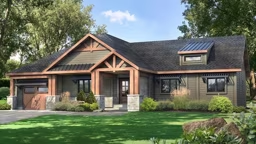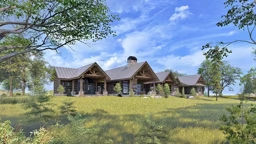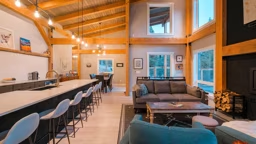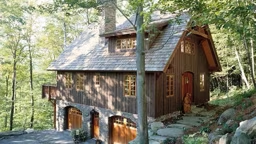
The arched black cherry tie beam, the curved braces, and the well-crafted stonework make the entrance to the Mountain Top Arboretum education center very inviting.
By Jack A. Sobon
We can build our homes from lots of different materials: from off-the-shelf materials available at the local builder’s supply to exotic and expensive goodies from around the world. For the techies, there are some incredible “engineered” materials incorporating the latest research and trends. In fact, thanks to the internet, there is now an unlimited variety to pick from. It can be overwhelming at times. Many products advertise themselves on the sides of buildings under construction to make the general public familiar with the brand. This gives clients the feeling of being left out if they don’t see the popular logo spread all over their own house under construction. I once asked a clerk at a lumberyard, “What about this product; is it any good?” His answer: “Yup, that’s what they are all buying.” That says it all!
Even the authorities who write the building codes seem to be in on it. Codes are constantly updated to allow new products to be used and, in some cases, these products are required. New products from the industry giants are generally encouraged over those from the little guys. Testing and approval of new materials requires a great deal of investment: too much for some backyard inventor. Much like in the decisions of our government, money has the biggest say in the building industry today.

The bold, earthen colors are in harmony on this wattle-and-daubed timber-frame wall at the Norse Folk Museum in Oslo, Norway.
Color
Building materials should enhance our quality of life and boost our spirits. Color can be important in this respect. There is quite a science about the effects of color on humans. Artists, advertisers and graphic designers all use it to great effect. Color done right improves life; color done wrong worsens it. Many people don’t get the connection! As a boy going to school in the sixties, I remember many classrooms painted the same ugly green color. Years later I learned that particular color, called “institutional green,” was determined by government researchers to be the color best suited to keeping those wilder youngsters under control. That’s something to keep in mind if you have one. Color is subliminal.
So what are the best colors? Earth tones with rich, warm hues, like those found in nature, often create the most comfortable environments. Unlike most man-made materials and colors, natural colors are not uniform nor pure. They are made up of several colors and can change their appearance depending on the sunlight or season. They are easy on the eye. Those colors are hard to duplicate in the factory. Materials taken from the earth (like stone) or harvested from the forest (like wood) come with a great variety of the natural colors automatically. It is hard to go wrong when using them.

These 300-year-old chamfered timbers have certainly aged gracefully, taking on a rich patina. How many of our modern materials will still look good after even only 20 years?
Good Local Materials
Good materials are locally sourced, with a minimum of processing, and can be harvested sustainably. They aren’t a rare resource, they don’t create toxins during their processing or harm humans that handle them, and they don’t need a lot of wasteful packaging that ends up in landfills. Many so-called “green” building materials marketed today are really not that green. For instance, a natural, beautiful, nontoxic building product may have been shipped several thousand miles to your building site, perhaps crossing an ocean. No matter how they spin it, that just isn’t green!
These good materials should last indefinitely or at least be easy to renew. If they wear easily, they should wear gracefully. Honest materials have their color throughout, not just a surface application. Over time, they take on a patina, which makes them even more handsome than when they were first installed. They may absorb the oils from thousands of hands rubbing across them (like a wooden handrail) or gain a scalloped depression after being stepped on for decades (like a stone stair).
Materials used on a house’s exterior should weather well and gracefully. If properly applied, wood siding can last for centuries without any toxic chemical preservative. It will wear away over time from ultraviolet rays, windblown sand, frost, and microorganisms — roughly a quarter of an inch every century. It may get deeply furrowed, like driftwood, and its knots, being relatively hard, will wear less than the wood around them. Though the wood will become thinner, it should still be sound. If a board here or there gets cracked, worn through, or rots because the earth was too close, it can be replaced with another without too much trouble.
I still remember the first time I removed some original white pine siding boards from a barn built before 1800; it had never been painted or stained. The boards had beautiful color variations and were gracefully furrowed, highlighting the grain, but they were only about half an inch thick. Where they were tucked up under the eaves or behind a trim piece, out of the weather, they were still a full inch thick. Also, the knots were raised and highlighted. Each board was a natural work of art. I subsequently learned that boards such as those are valuable. Wealthy clients would pay hefty sums (10 to 20 times that of a newly sawn pine board) for those boards to adorn their country house interiors. Again, it would be hard to duplicate this look in the factory.
Do all materials in a home have to comply with the above ideals? Not necessarily, but as many as possible should, when practical. Unless you live in an industrial area, you would be unlikely to get your plumbing or electrical components locally, so there will be some compromises. But if you keep these concepts in mind as you select building components, you will be more likely to live in a house that will enhance your life and age beautifully and gracefully.

Countless hands have turned on the rounded top of this Shaker newel post, and yet it is still a beautiful thing to behold.
Details and Finish
When selecting finish materials for a home, it is important that there be some consistency in the level of finish on those materials. For instance, rough wood surfaces are fine as long as the adjacent material surfaces are equally rough and irregular. Rough timber, stone, brick, wrought iron, clay tile, leather, cast bronze and unpainted plaster are all compatible. Combining polished, slick and angular materials with rougher, imperfect surfaces can be challenging. And, generally, the more perfect the materials are, the fussier their detailing becomes. A rough end cut of a perfectly flat, uniform material is as incompatible as a fine, precise cut on a rough material. When we use uniform, modern materials, we expect them to be perfect. The eye easily picks up any irregularities, blemishes or imperfections, and we find them disconcerting. The tradesperson must be ever vigilant in selecting and installing such materials. As an occupant, we must also be vigilant not to mar, crack, or stain such perfect materials.
- Excerpted from Hand Hewn ©2019 by Jack A. Sobon. Used with permission from Storey Publishing.
Read More:
*All products featured are selected by our editors. When you make a purchase through a qualifying link, we may earn a commission via affiliate programs with Amazon.com and other retailers.

By Jack A. Sobon
It’s not often when you come across a book that conveys a rich piece of history in a compelling and beautifully illustrated way. It’s even more rare when the topic is the craft and tradition of timber framing. But that’s exactly what Jack Sobon accomplished in Hand Hewn: The Traditions, Tools and Enduring Beauty of Timber Framing.
Hand Hewn is an autobiography, a history lesson, an informational wood science/instructional guide and a gorgeous coffee table book all rolled into one. It elegantly showcases the centuries-old legacy of timber craft, sheds light on the reasons behind its modern resurgence and points to a strong future for this enduring home style.
Sobon is not only an architect and master craftsman specializing in timber-framed structures, he’s a founding director of the Timber Framer’s Guild. For nearly 40 years he has devoted his career to transforming trees into lasting works of art. There’s no better person to tell timber framing’s story.











